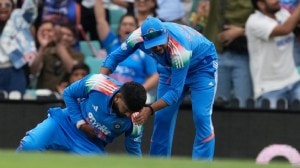Behind the rules: ICC prepares a batting wicket
Much of what has been said in recent times on the subject of India’s new coach has been unbecoming and disappointing. The other committ...

Much of what has been said in recent times on the subject of India’s new coach has been unbecoming and disappointing. The other committee that Sunil Gavaskar sits on has turned out something far more interesting and worthy of debate. They have addressed the issue of the future of one-day cricket head-on and shown that they are quite willing to move with the times. You may not agree with everything but you cannot fault it on intent.
The most interesting of them all is the suggestion that teams play 12 players with 11 on the field at any time. You can see the effort to upgrade the action in the middle overs by inviting teams to pick five quality bowlers. Theoretically it should make run-getting more difficult and throws a lifeline to the single-skilled cricketer. Bowlers who carry the bat as a formal, if unnecessary, implement can have a role to play, so too the portly batsman who can score 50 but let go 30.
My feeling, though, is that it will benefit teams that already bat well, allowing them to continue playing seven batsmen and pick a fifth bowler. The wicket-keeper will still need to bat, indeed this new indulgence does little for the fine ’keeper who can’t make a quick 30 or a dogged 40. Like before, teams with all-rounders will continue to have an advantage and if teams don’t have a batsman who can bowl or a wicket-keeper who can bat, they will still struggle.
It will mean little to India, for example. It is too early to assess whether Dhoni will be a proper batsman for otherwise we will have to play six batsmen, a wicket-keeper and five bowlers which is better than before but not too good against teams that have seven batsmen and five bowlers, and a couple of all-rounders as well.
Pakistan will benefit for it will allow them to play an extra batsman and Australia will probably be best off for they can now play an extra genuine bowler.
You can see that the desire is to create a more interesting confrontation between bat and ball but between that desire and reality stand 22 yards of the most barren surface in our solar system. Unless pitches become better, unless we stop some of the nonsense we have had over the last 12 months, it won’t matter much if you allow a side to play five bowlers or eight. When India played Pakistan recently, the regular bowlers were going for as many runs as the part-timers.
Sadly, I suspect, we will continue to have more bat vs bat situations and with batting depth likely to increase, I think 350 could well become a par score sooner rather than later. Indeed, 400 is now round the corner.
And so, while on the surface, the 12 player-a-side rule clearly invites the specialist bowler, it needs to be looked at or, as the lawyers might say, read with, the increase in the number of overs with field restrictions. Indeed what the committee gives the bowler with one hand, it takes away with another. Conversely put, if the demand was to produce brighter cricket (and that doesn’t always mean more runs!) this is the route the committee has devised to give something to the bowler!
It makes life tougher for the spinner, who now has a 30-over window to bowl in rather than the 35 he had before. Two spinners will become a luxury unless the pitches are really low and dusty and the need for a spinner who can bat, or a batsman who can turn the ball, becomes greater.
Most interesting, though, is the suggestion to allow the fielding captain to nominate ten of the twenty overs with field restrictions. Sharp readers might recall that the initial idea was to allow the batting side to pick which overs were to have field restrictions.
The thinking behind that was appropriate. Otherwise, in a situation where it was going to rain in the second innings, the fielding side could have ensured that the batting side got to play no overs at all with field restrictions.
If, for example, team A made 280 and it became clear that Duckworth Lewis would come into play, they could then open out the field from the first ball and play up to 35 overs like that ensuring that team B always had to bat with five men on the boundary line.
Now with the stipulation that the first 10 overs have to have field restrictions, the control over the next 10 can go to the fielding captain without fear of the above situation.
Twenty still seems to be too many overs, and on the surface it seems like another rule in favour of the batsmen, but it will be interesting to see how sharp minds use such a regulation. If the game does move into a 350-400 run situation though, the quality of the fieldsmen will become even more critical.
Greater use of technology was inevitable — but that is the subject of another story!



- 01
- 02
- 03
- 04
- 05




























